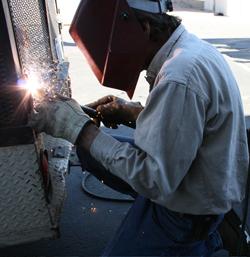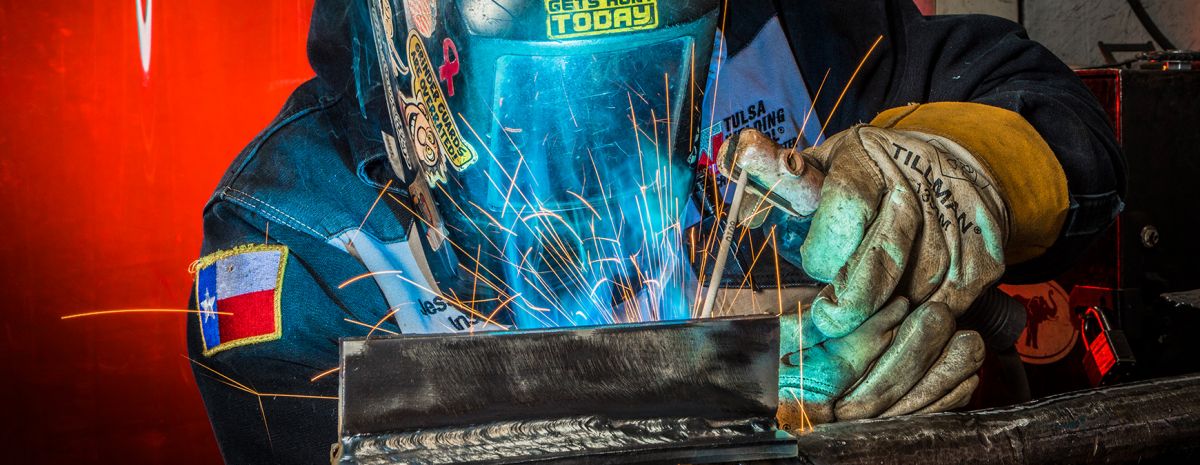Typical Welding Repair Issues and Just How to Address Them Effectively
Welding repairs often come across a variety of problems that can endanger the stability of the end product. Common problems consist of insufficient infiltration, porosity, and misalignment, to name a few. Each defect offers unique challenges that need specific strategies for resolution. Understanding these issues is crucial for welders aiming to boost their outcomes and skills. This conversation will check out these common welding repair work concerns and efficient techniques to resolve them.
Poor Infiltration
Insufficient penetration occurs when the weld steel falls short to completely fuse with the base product, resulting in weak joints and potential architectural failures. This concern typically originates from not enough warm input, inaccurate electrode angle, or improper welding speed. Welders might encounter poor penetration due to a miscalculation of the essential specifications for a specific material thickness or kind. Additionally, contamination on the base product's surface can prevent reliable bonding, worsening the issue. To attend to poor penetration, welders need to assure ideal settings on their equipment and keep a clean job surface area. Routine assessment of welds is suggested to identify any kind of shortages early, enabling timely corrections and the avoidance of endangered structural integrity in welded assemblies.
Porosity
Porosity is a common flaw in bonded joints that materializes as small gas bubbles caught within the weld metal. This issue can jeopardize the honesty of the weld, bring about reduced strength and potential failure under stress and anxiety. Belgrade Welding. Porosity typically develops from contamination, dampness, or improper welding methods, which allow gases to run away right into the liquified weld pool. To attend to porosity, welders ought to guarantee correct surface area preparation, keep a clean workplace, and use suitable welding parameters. In addition, choosing the right filler product and shielding gas can reduce gas entrapment. Routine evaluation and testing of welds can aid identify porosity early, assuring timely restorative activities are taken, therefore preserving the high quality and dependability of the bonded framework
Misalignment
Imbalance in welding can emerge from various aspects, consisting of improper arrangement and thermal expansion. Recognizing the origin is vital for reliable resolution. Several adjustment methods are offered to realign parts and ensure architectural honesty.
Reasons of Misalignment
Welding imbalance often stems from a range of underlying problems that can compromise architectural honesty. One main cause is inappropriate fit-up of components before welding, which can bring about gaps and irregular surfaces. Variants in thermal expansion throughout the welding procedure can additionally result in distortion, particularly if the materials being signed up with have various coefficients of development. In addition, poor fixturing and securing may fall short to hold elements securely in position, resulting in motion throughout welding. Badly maintained devices, consisting of welding devices and tools, may introduce inconsistencies in the weld grain, further adding to imbalance. Operator mistake, stemming from insufficient training or experience, can also play a substantial duty in creating misaligned welds.

Correction Strategies Available
Resolving misalignment effectively calls for a combination of corrective strategies tailored to the details problems at hand. One common method is using jigs or components to hold elements in the proper setting throughout welding, ensuring constant positioning. In addition, pre-heating the materials can help in reducing distortion and enhance fit-up. For substantial imbalance, mechanical adjustment strategies, such as utilizing hydraulic jacks or clamps, can be used to correct the setting prior to welding. Post-weld heat therapy might likewise be required to soothe anxieties triggered by imbalance. Careful examination and modification throughout the setup phase can prevent imbalance problems from ending up being considerable problems, advertising a smoother welding process and enhancing total structural honesty.
Distortion
Distortion is a typical obstacle in welding that can occur from different factors, including irregular home heating and cooling. Recognizing the reasons of distortion is vital for carrying out efficient prevention strategies. Resolving this concern not only improves structural integrity however likewise boosts the general quality of the weld.
Sources of Distortion
When subjected to the intense warm of welding, products typically go through modifications that can cause distortion. This phenomenon largely develops from thermal development and contraction during the welding process. As the weld location warms up, the product increases; upon cooling, it acquires, which can produce internal anxieties. On top of that, irregular home heating across a work surface can worsen these stress and anxieties, resulting in bending or bending. The kind of product also plays a substantial duty; steels with differing thermal conductivity and coefficients of growth may respond in a different way, causing uncertain distortions. Bad joint style and insufficient fixturing can contribute to imbalance throughout welding, increasing the probability of distortion. Understanding these reasons is necessary for reliable welding repair work and avoidance methods.
Avoidance Techniques
Efficient prevention methods for distortion throughout welding focus on controlling warm input and making certain appropriate joint layout. Maintaining a constant heat input helps to reduce thermal expansion and contraction, which can lead to distortion. Using strategies such as pre-heating the work surface can additionally decrease the temperature level slope, advertising uniform heating. Additionally, choosing ideal joint designs, such as T-joints or lap joints, can enhance security and minimize tension focus. Executing correct fixturing to protect the work surfaces in position even more aids in keeping placement during the welding procedure. Finally, staggered welding series can distribute warm more equally, preventing local distortion. By applying these methods, welders can significantly decrease the likelihood of distortion and boost the total quality of their welds.
Cracking
Cracking is an usual problem come across in welding repairs, usually arising from different aspects such as incorrect cooling rates, best 220v mig welder material selection, or poor joint prep work. The event of fractures can greatly jeopardize the honesty of the weld, resulting in potential failings during procedure. To resolve this concern, welders have to first examine the origin, ensuring that products work and suitably selected for the particular application. Additionally, regulating the cooling price throughout the welding process is essential; rapid cooling can cause tension and lead to splitting. Proper joint design and prep work likewise contribute to lessening the threat. Implementing these techniques can boost weld top quality and durability, ultimately lowering the chance of splitting in ended up weldments.

Incomplete Fusion
A substantial problem in welding repairs is incomplete blend, which takes place when the weld steel does not appropriately bond with the base product or previous weld passes - Fabrication. This issue can cause weak points in the joint, possibly compromising the honesty of the bonded framework. Variables contributing to incomplete fusion consist of not enough heat input, improper welding technique, and contamination of the surfaces being joined. To address this concern properly, welders need to assure proper pre-weld cleaning and surface preparation, in addition to adjust their welding specifications to attain ample infiltration and fusion. Regular inspection throughout the welding procedure can likewise help determine incomplete fusion early, allowing for timely corrective procedures to enhance the total high quality of the weld
Overheating
While welding repairs can boost structural honesty, overheating offers a significant obstacle that can bring about product degradation. Excessive warmth during welding can modify the mechanical residential properties of steels, leading to lowered strength, increased brittleness, and warping. This sensation is particularly important in high-stress applications where structural integrity is extremely important. Identifying overheating can entail aesthetic examinations for discoloration or distortion, in addition to keeping an eye on temperature during the welding procedure. To mitigate the threats linked with getting too hot, welders ought to utilize appropriate techniques, such as regulating warmth input, changing traveling rate, and using ideal filler materials. Additionally, implementing pre- and post-weld warm therapies can help bring back material buildings and boost the overall high quality of the fixing, ensuring lasting efficiency and security.
Frequently Asked Questions
What Are the Typical Signs of a Welding Problem?

How Can I Examine My Welds for Quality?
To examine welds for top quality, one can utilize aesthetic evaluations, ultrasonic screening, and radiographic approaches. Each strategy assures architectural integrity, recognizes defects, and confirms adherence to Learn More defined requirements, ultimately enhancing the reliability of the bonded joints.
What Safety Preventative Measures Should I Take While Welding?
When welding, one must focus on security by using proper individual protective devices, ensuring proper air flow, securing flammable materials away, keeping a clean work space, and knowing surroundings to stop injuries and mishaps.
Can I Repair a Weld Without Remodeling the Entire Joint?
Repairing a weld without remodeling the whole joint is possible, depending on the damages (Montana Mobile Welding and Repair). Strategies such as grinding, including filler material, or using a welding procedure can efficiently deal with certain defects while maintaining the surrounding framework
What Equipment Are Crucial for Effective Welding Services?
Vital devices for efficient welding fixings include a welding maker, wire brush, grinder, protective equipment, clamps, and filler materials. combo welder Each tool plays a vital function in guaranteeing top quality and security throughout the fixing process. Porosity commonly develops from contamination, dampness, or inappropriate welding strategies, which permit gases to leave into the molten weld pool. Inadequately kept devices, including welding equipments and devices, may introduce incongruities in the weld grain, more contributing to misalignment. When subjected to the extreme warmth of welding, products usually go through adjustments that can lead to distortion. Cracking is a common concern come across in welding repairs, frequently resulting from different variables such as inappropriate cooling prices, material choice, or inadequate joint preparation. A considerable problem in welding repairs is incomplete blend, which happens when the weld steel does not adequately bond with the base product or previous weld passes.